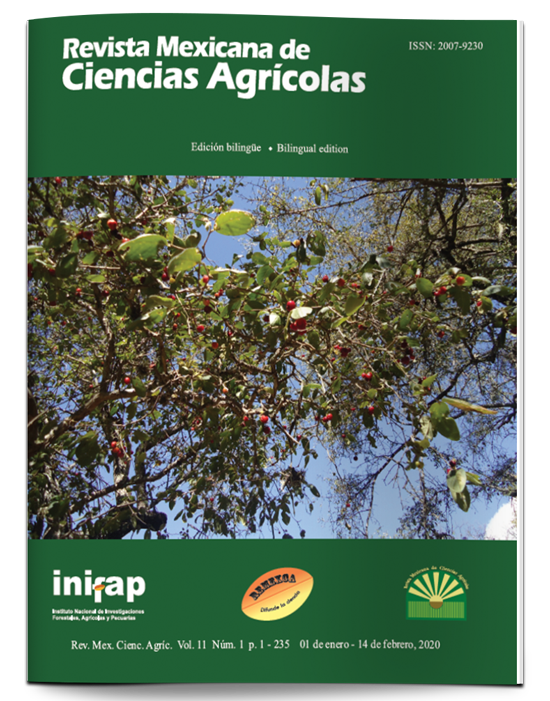Virus de la hoja rizada de calabaza (SLCV): diagnóstico, dinámica poblacional del vector y distribución espacio-temporal del virus
DOI:
https://doi.org/10.29312/remexca.v11i1.1754Palabras clave:
Bemisia tabaco, Cucurbita pepo, Geminivirus, severidadResumen
Los miembros del género begomovirus se transmiten por Bemisia tabaci y causan severas pérdidas en las cucurbitáceas. Los objetivos del estudio fueron: i) investigar la etiología de la enfermedad provocada por el virus de la hoja rizada de la calabaza; ii) conocer la dinámica de población del vector, comparar la efectividad de trampas amarillas pegajosas contra charolas amarillas y determinar el efecto del sitio de ubicación de las trampas, en el monitoreo de B. tabaci durante el ciclo de desarrollo del cultivo; y iii) estudiar la distribución espacio-temporal y severidad de virosis en calabaza. El estudio se realizó en la estación experimental del Colegio Superior Agropecuario del estado de Guerrero, ubicado en el Valle de Cocula. Se realizó la extracción del ADN a partir de hojas de calabaza (Cucurbita pepo) var. Grey Zucchini con síntomas de virosis. El PCR se llevó a cabo en cinco muestras con los oligonucleótidos genéricos para begomovirus, se secuenciaron dos productos de PCR y se generó un árbol filogenético. Se realizó la prueba de transmisión del virus en calabaza, en condiciones controladas. La dinámica poblacional de B. tabaci se determinó utilizando trampas amarillas pegajosas y charolas amarillas. A partir, de la sintomatología, se obtuvo el porcentaje de severidad y el área bajo la curva del progreso de la enfermedad (ABCPE). El análisis de PCR, secuenciación y filogenia, confirmaron la presencia del virus SLCV (KX620945.1-DAAV-1) en calabaza. Se comprobó que B. tabaci transmite a SLCV que reduce el crecimiento de la planta. La trampa pegajosa y fecha de muestreo influyen en la fluctuación poblacional de B. tabaci. La incidencia de B. tabaci y severidad de SLCV se manifestaron en todas las etapas fenológicas del cultivo y se relacionaron con el nivel de temperatura.
Descargas
Descargas
Publicado
Cómo citar
Número
Sección
Licencia
Los autores(as) que publiquen en Revista Mexicana de Ciencias Agrícolas aceptan las siguientes condiciones:
De acuerdo con la legislación de derechos de autor, Revista Mexicana de Ciencias Agrícolas reconoce y respeta el derecho moral de los autores(as), así como la titularidad del derecho patrimonial, el cual será cedido a la revista para su difusión en acceso abierto.
Los autores(as) deben de pagar una cuota por recepción de artículos antes de pasar por dictamen editorial. En caso de que la colaboración sea aceptada, el autor debe de parar la traducción de su texto al inglés.
Todos los textos publicados por Revista Mexicana de Ciencias Agrícolas -sin excepción- se distribuyen amparados bajo la licencia Creative Commons 4.0 atribución-no comercial (CC BY-NC 4.0 internacional), que permite a terceros utilizar lo publicado siempre que mencionen la autoría del trabajo y a la primera publicación en esta revista.
Los autores/as pueden realizar otros acuerdos contractuales independientes y adicionales para la distribución no exclusiva de la versión del artículo publicado en Revista Mexicana de Ciencias Agrícolas (por ejemplo incluirlo en un repositorio institucional o darlo a conocer en otros medios en papel o electrónicos) siempre que indique clara y explícitamente que el trabajo se publicó por primera vez en Revista Mexicana de Ciencias Agrícolas.
Para todo lo anterior, los autores(as) deben remitir el formato de carta-cesión de la propiedad de los derechos de la primera publicación debidamente requisitado y firmado por los autores(as). Este formato debe ser remitido en archivo PDF al correo: revista_atm@yahoo.com.mx; revistaagricola@inifap.gob.mx.
Esta obra está bajo una licencia de Creative Commons Reconocimiento-No Comercial 4.0 Internacional.



